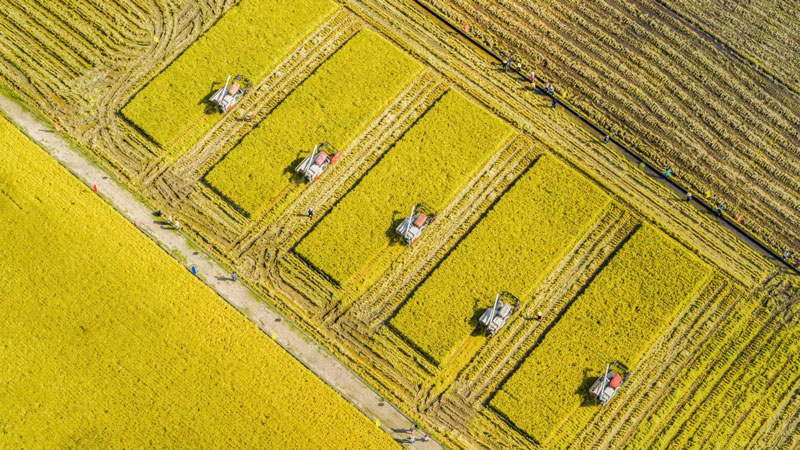China's ecosystems restoration project contributes to world ecological progress

Photo taken on Dec. 18, 2022 shows a beautiful section of the Xin'an River in Huangshan, east China's Anhui province. (Photo by Xiao Benxiang/People's Daily)
China's Shan-Shui initiative, which translates to "mountains and rivers," was recently recognized as one of the ten World Restoration Flagships at the 15th Conference of Parties (COP15) to the UN Convention on Biological Diversity meeting held in Montreal, Canada.
The initiative combines dozens of large-scale projects nationwide to restore ecosystems, including mountains, rivers, forests, farmlands, lakes, grasslands and deserts.
The UN Environment Programme (UNEP) said the Shan-Shui initiative sees all ecosystems as a part of a community of all life on Earth, and has restored millions of hectares of land through relentless efforts.
The Shan-Shui initiative is a signature project explaining how China practices the vision that "Mountains, rivers, forests, farmlands, lakes, and grasslands are a life community."
Since 2016, the country has implemented 44 projects under the initiative at critical ecological spots in the Three Eco-zones and Four Shelterbelts – the Qinghai-Tibet Plateau Eco-zone, the Yellow River Eco-zone, the Yangtze River Eco-zone, the Northeast Shelterbelt, the North Shelterbelt, the South Shelterbelt, and the Coastal Shelterbelt.
The Shan-Shui initiative aims to launch integrated protection and systematic governance of all ecological elements in different regions, and strives for holistic and comprehensive ecological benefits.
In 2020, multiple government departments jointly issued a guideline that regulates the implementation of Shan-Shui projects according to five principles, such as "prioritizing ecological conservation and pursuing green development," and "integrating natural restoration as the main and artificial restoration as a supplement."
Multiple regions in China are at the forefront of implementing the Shan-Shui initiative. They have opted for technical models according to local conditions including ecological degradation, damage and resilience of ecosystems, creating valuable experiences for the construction of a beautiful China.
Hefei, east China's Anhui province has launched a six-phase ecological protection and restoration project for Chaohu Lake, during which 10 wetlands have been built around the lake.
Central China's Hubei province implemented a restoration project that well coordinates the treatment of various ecosystems to build an ecological shelterbelt in the Three Gorges region, exploring a "Hubei model" that addresses comprehensive and whole-process ecological issues.
Gansu province in northwest China launched an integrated restoration project for the mountains, rivers, forests, farmlands, lakes, grasslands and deserts on the upper reach of the Yellow River in Gannan Tibetan autonomous prefecture. It also built several major pilot national parks to build an ecological barrier in the upper reach of the Yellow River.
The Shan-Shui initiative has created huge benefits. For instance, the Three Gorges section of the Yangtze River in Hubei province, which was once surrounded by chemical engineering enterprises, is now seeing the return of Yangtze finless porpoises.
In addition, the mainstream of the Yellow River in Gannan Tibetan autonomous prefecture recharges 58.7 percent of the runoff in the source region of the Yellow River. Hefei has been credited by the Ramsar Convention as an international wetland city.
So far, China has completed ecological protection and restoration of more than 3.5 million hectares. It plans to restore ten million hectares of vital ecosystems by 2030. The country has achieved a series of innovation outcomes in organization models, implementation methods and technical standards.
The World Restoration Flagships were selected under the banner of the United Nations Decade on Ecosystem Restoration, a global movement coordinated by the UNEP and the UN Food and Agriculture Organization (FAO).
The ten flagships proved this time aim to restore more than 68 million hectares and create nearly 15 million jobs. They will be eligible for UN funding and technical support.

Photo taken on Dec. 19, 2022 shows oriental white storks wintering in a national wetland park in Hefei, east China's Anhui province. The wetland park, as one of the wetlands built by Hefei around Chaohu lake, has attracted flocks of migratory birds. (Photo by Wang Shibao/People's Daily Online)

Photo taken on Nov. 9, 2020 shows a curving section of the Yellow River in Muxihe township, Maqu county, Gannan Tibetan autonomous prefecture, northwest China's Gansu province. (Photo by Jiang Aiping/People's Daily Online)
Photos
Related Stories
Copyright © 2022 People's Daily Online. All Rights Reserved.









